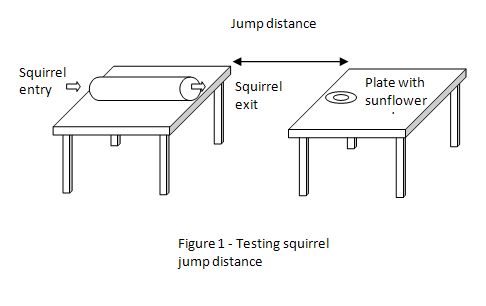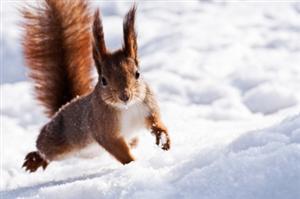| Complexity level: | 7 |
| Project cost ($): | 30 |
| Time required: | 1 hour to prepare, 1 day for the science project experiment |
| Material availability: | You will need 5 squirrels for this experiment |
| Safety concerns: | Ensure that you wear safety gloves when handling the squirrels, to avoid being injured. Adult supervision required. |
Hypothesis
Squirrels are able to jump a distance of at least 1 meter.
Overview
Squirrel
Squirrels are small-sized rodents that belong to a species of animals called Sciuridae. Other animals in this species include the tree squirrel, flying squirrels, ground squirrels, chipmunks and prairie dogs. The size of an average squirrel is about 40cm from nose to the tail tip. Their weight is about 500grams.
Squirrels have large eyes, a slender body and bushy tails. Their large eyes mean that they have very good vision. This is especially important for tree dwelling squirrels. Their bushy tail help them keep balance, cushion their falls and to communicate with other squirrels. Squirrels also have sturdy and versatile claws that helps them grasp branches and tree trunks as they climb.
The squirrel is a natural herbivore and lives mainly on nuts, fruit, mushrooms, seeds, vegetables and interesting, conifer cones (eg. pine cones). However, squirrels are also known to eat meat when they are starved. They eat bird eggs, small insects, small snakes and other small rodents.
Scientific Terms
Materials
The materials required for this science fair project:
- 2 tables
- 5 squirrels
- 1 PVC pipe with a diameter of about 10 cm and length of 500mm
- a thin soft mattress or a large pillow
- 1 bag of sunflower seeds
- 1 plate
- 1 measuring tape
Procedure
1. For this science fair project, the independent variable is the distance between the tables. The dependent variable is the distance jumped by the squirrels (from table to table). This is determined by measuring the distance between the tables. The constants (control variables) are the feed used to make the squirrel jump from table to table and the incremental distance between the tables between each jump.
2. The 2 tables are arranged 300mm apart as shown in table 1 below. The PVC pipe is placed on the 1st table, and the plate filled with the sunflower seeds, is then placed on the 2nd table. Place the mattress or pillow between the tables, to provide the squirrels with a soft landing.
 3. The squirrels are released one at a time into the rear opening of the pipe as shown in figure 1. As they move along the pipe and reach the other end, they will see a plate full of sunflower seeds on the other table. As the squirrel attempt to jump from the edge of the pipe to the next table, whether or not it succeeds in landing on the next table, is recorded in the table given below.
3. The squirrels are released one at a time into the rear opening of the pipe as shown in figure 1. As they move along the pipe and reach the other end, they will see a plate full of sunflower seeds on the other table. As the squirrel attempt to jump from the edge of the pipe to the next table, whether or not it succeeds in landing on the next table, is recorded in the table given below.
4. The distance between the tables will be increased by another 300mm and procedure 3 is repeated.
5. Procedures 3 and 4 are repeated until all 5 squirrels are unable or unwilling to make the jump any longer.

Results
It was observed that the squirrels were able to jump an average distance of between 1 meter and 1.5 meters. The furthest jump was 1.5 meters, achieved by squirrel number 2 and number 4.
|
Squirrel Number |
Distance successfully jumped by the squirrels |
|||||
|
300mm |
600mm |
900mm |
1200mm |
1500mm |
1800mm |
|
|
Squirrel 1 |
√ |
√ |
√ |
√ |
X |
X |
|
Squirrel 2 |
√ |
√ |
√ |
√ |
√ |
X |
|
Squirrel 3 |
√ |
√ |
√ |
√ |
X |
X |
|
Squirrel 4 |
√ |
√ |
√ |
√ |
√ |
X |
|
Squirrel 5 |
√ |
√ |
√ |
√ |
X |
X |
√ - jump successful, X – jump not successful
Conclusion
The hypothesis that squirrels would be able to jump a distance of at least 1 meter, is proven to be true.
Squirrels are normally active during the day and we can normally notice them running about and jumping between tree branches in parks. Squirrels are in fact able to jump the distance of about 20 to 30 times their body lengths!
Also consider
What would happen if the science fair project was repeated to compare male squirrels and female squirrels?
The science fair project can be further repeated by increasing the height of the PVC pipe and reducing the height of the 2nd table.
References
Squirrel - http://en.wikipedia.org/wiki/Squirrel
Grey squirrels - http://www.kafox.freeserve.co.uk/fluffy/fluffy.html

